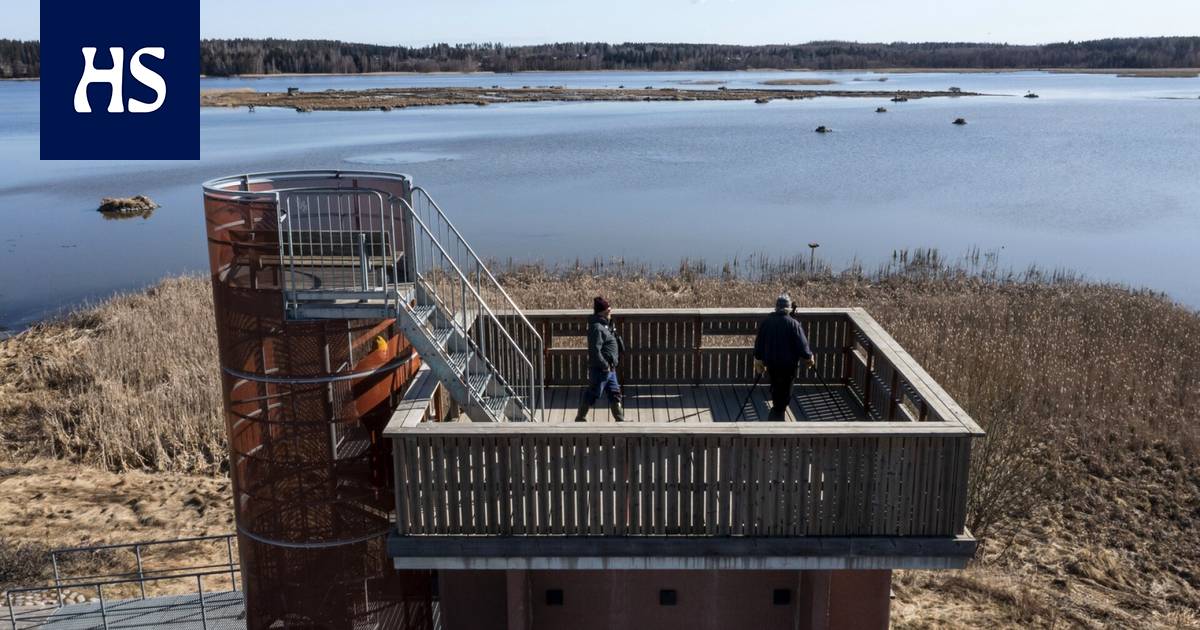Rainer Mäkelä and Tatu Itkonen shoveled, riveted and carried stones for thousands of hours. Lintujärvi rewarded the work by coming to life.
Lempäälä.
At the beginning of there was a choking lake, two shovels, and two men. Later, a Toyota Yaris rolled into the picture, with a respectable-sized rubble crushed on the front seat.
The work began at the turn of the millennium. Bird watchers from Pirkanmaa Rainer Mäkelä and Tatu Itkonen wanted to take action, as Lempäälä ‘s Ahtialanjärvi – the famous bird water – was growing up.
Life was already quiet. The wading birds could not find resting places, the community of laughing gulls disintegrated, ducks and messes diminished.
The same problems have been seen in Finnish bird waters everywhere. The nutrients flowing from the fields eutrophicate the lakes and bays, and the sludge beaches, which are important for waders, are growing up. There will be a reed, a bush and eventually a forest.
Water birds in Lake Ahtialanjärvi were also burdened by water level changes and land predators due to hydropower and flood regulation, such as the alien species raccoon dog and mink.
The shovel and the scythe helped to push. Mäkelä and Itkonen began digging springs that remained in the water. In addition, they began mowing the hive crops of the alien duck every fall to leave room for native plants such as furrows and cards.
Mäkelä and Itkonen have continued both jobs for 20 years and thousands of hours, almost without pay. Last autumn, 295 hours went to mowing alone, according to Mäkelä’s accounts.
And that rockstone on the front seat of the Toyota Yaris? It was spun from the car to the boat and from the boat to the bottom of the lake in 2009 to form the first artificial lake in Ahtialanjärvi. With artificial reefs, birds can nest safely from landfills and rising water.
Today, there are 45 reefs in the lake, and Lake Ahtialanjärvi is one of Finland’s most valuable bird destinations.
The Canada goose hatched its eggs in the artificial reef of Lake Ahtialanjärvi. Next to it you can see a nest box installed by Rainer Mäkelä and Tatu Itkonen, inside which a mallard is buried.
Boat is stuck at the bottom in the mud of Lake Ahtialanjärvi, and Mäkelä is struggling with oars. Mäkelä spends all his free time working at Lintujärvi, and it doesn’t bother him at all.
“This is rewarding!” he exclaims and smiles like the sun of Naantali.
Over the years, sometimes EU money has been raised for the operations and some of the excavations have been possible with an excavator. Artificial boulders have also been made by dropping stone loads on the truck. Yet the vast majority of the work is done on their own, physically. “A lot has been shoveled, it’s true.”
Mäkelä’s salary comes from the work of a maintenance man, but the main mental work is this lake, where laughter logs are now screaming. A wife was also found on the shore of the lake ten years ago. He had come to the edge of the sludge to marvel at the renovation work. Now the wife is finalizing a dissertation on the psychological effects of bird ringing.
Mäkelä seems happy even when stuck in the mud. “I like that there are a lot of birds, a lot of life.”
Rainer Mäkelä moves in Ahtialanjärvi by rowing, although sometimes he gets stuck.
It is an early and cold May morning. The Canadian goose, next door, has a plywood box installed by Mäkelä and Itkonen. Between the litter placed inside it is split by a mallard.
The dry hay put in the box in the spring reportedly gives the studio the final wow effect that seals the purchase decision for the duckling.
The female and male redfish swim in a row in Ahtialanjärvi. The coolness of the mornings has still curbed the biggest group instruments.
There are already 150 nest boxes in the lake. Both are rapidly declining species in Finland, and the red sword threatens to disappear from Finland altogether.
Thanks to Mäkelä and Itkonen, Ahtialanjärvi has become the most important nesting site for redfish in Finland. There were already twenty couples last year, compared to four at the start. After all, they are still surrounded by three pairs on the outskirts of one artificial herd. The group music is in its infancy. Red-headed dogs swim strangely around the neck, chamfering the surface of the females.
The red telescope, red hair, and Canada goose were visible through the telescope.
In addition to the mess, the prides of Lake Ahtialanjärvi include the cape frogs that are about to start spawning, a column of more than 3,000 laughing logs and 150 pairs of terns perched on a new 55-meter-long artificial reef. “Terns in particular are great air defenders,” says Mäkelä. This year they have not yet arrived.
The air domination provided by seagulls and terns is an integral part of the life of a bird lake. They evacuate birds of prey and small predators by force and create a protection zone where other birds dare to nest.
The laughing gull flew over the blue duck in Ahtialanjärvi in front of Lokkisaari.
However, no defense is seamless. A pair of beach spruce crows have begun to learn that eggs can be found in the boxes. Now, in a cold and hungry spring, tragedy follows one after another as crows watch as each mother has had her egg laid.
It has made Mäkelä think about the extent to which the flow of nature can be addressed. If you have already dug up springs, mowed reeds and built nest boxes, shouldn’t the crow, who is robbing the nest of the ultra-rare red raven, also be evicted?
“All of this is artificial, but this nature is no longer self-healing here.”
The heart of Ahtialanjärvi is Lokkisaari, which Rainer Mäkelä and Tatu Itkonen have considered ideal for waders and waterfowl by digging, mowing and building nesting sites.
Boat detaches from the bottom by pushing with an oar and we get to land on the shore of Lokkisaari. It is a shallow island and the heart of the lake. “Oh no!” Mäkelä exclaims. The wind has folded the tarpaulins they have set up to extinguish the flocks of the invasive alien species that is invading the island.
The shoes sink into the mud, and Mäkelä begins to tell the history of the lake. The initial situation in the 18th century was that the surface of the lake was four meters higher. Every spring, as the snow melts, the entire area is flooded with several square kilometers. Those huge sludges, sedges and floodplain meadows were the original habitat whose organisms are now found in the best bird lakes.
In Lokkisaari, Rainer Mäkelä put in place a cover to extinguish the daisy species of the alien species.
Now we see in front of us an acre of sludge that remains like this with hard work. There are no more floods here along the Vanajaveden-Kokemäenjoki route. The eruption of rivers began as early as the 18th century, and after that their harnessing continued with hydroelectric dams as Finland industrialized. Now the water level is decided by the Pirkanmaa ely center. In the spring, water is collected behind the power plant dams and the water is at its lowest. Over the summer, the water level is allowed to rise to suit the cottages.
It’s a tricky equation for birds nesting on the water’s edge. The natural variation in water level would be the opposite.
The sea otter waded in the shore water of Lake Ahtialanjärvi.
“People understand that forest nature has been lost and bogs have been drained. But this loss of floodplain meadows happened so long ago that it is not remembered, ”says Mäkelä.
There is no return to the original state here. That would mean that many cottages and dwellings would have to rely on water. Mäkelä is grateful that the majority of the lake’s landowners have responded positively to their work. Otherwise, everything would not have been done.
Tatu Itkonen and Rainer Mäkelä watched the bird sanctuary of Ahtialanjärvi on a cool morning. The tower is close to the center of Lempäälä, so it is easy to get there.
Onshore Tatu Itkonen is waiting at the bird tower. For Itkonen, this lake has been the most important excursion destination since his youth. What has motivated him to spend so much time doing this?
“Anxiety about the deteriorating state of the birds,” he replies. “I find it very distressing.”
Read more: A scary message arrives from the sky: At the southernmost tip of Finland, there is a place closed to the public where the alarm state of Finland’s nature is perhaps more clearly visible than anywhere else.
Activities help. The majority of Finnish waterfowl are declining, although there are some positive examples, such as the Kuikka, the mallard and the national bird whooper swan.
Itkonen believes that the secret to Ahtialanjärvi’s success has been personal acquaintance. Every summer, Mäkelä and Itkonen have counted the number of nests and deduced what works and what doesn’t. “Bird waters are individuals,” says Itkonen.
Fish logs were on duty on the artificial herd.
There is now evidence of an increase in natural values, and as a reward for the management of Lake Ahtialanjärvi, money is coming from the state’s Pearl Program, which restores bogs and bird waters. The program is one of the most important nature activities of the current government.
Mäkelä fears that at many destinations, Pearl money may also be wasted if you do not think carefully about what to do. According to them, even the restoration of bogs is easy compared to the restoration of bird water.
“Even with some renovations, almost nothing is available,” says Itkonen. Restoration efforts are, in his view, too often one-off, costly bumps.
The aerial photo taken from Lokkisaari shows the covers used to suppress the alien duck and the hut on the right side, where wading birds are ringed during migration times. More than 30 wading species have been observed in Ahtialanjärvi.
Continuity would be better. Both of them also hope for Ahtialanjärvi. However, neither believes that it is possible to find the next generation of freelancers. It is hoped that the money from the Pearl Program will now enable a couple of people to be hired for seasonal work on the lake’s annual renovations.
“But I’m afraid it will still be a fight,” Mäkelä says and laughs. “If even the government changes.”
A osprey has appeared over Lokkisaari and the bridge is singing its own name in a coastal forest. The reporter has to get on the train, but work continues on the lake. “Let’s put those tarpaulins on Tatu,” Mäkelä shouts.
The bird towers will be filled on Saturday with enthusiasts
-
Bird waters are the focus of attention today, Saturday, when the big bird hobby event Battle of the Towers is held in the Finnish bird towers this spring.
-
The race tries to detect as many bird species as possible between five in the morning and one in the morning.
-
You can inquire about birds and birds at any bird tower, but special guided tours will be held at 10 am in the towers, which can be found at birdlife.fi/tt/yhdistystornit.
#Environment #unique #nature #paradise #born #complete #silence #Tampere #men #background





/s3/static.nrc.nl/wp-content/uploads/2024/04/web-1904binjohannvelkers.jpg)



